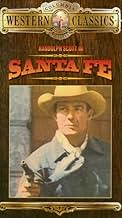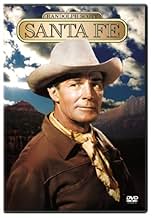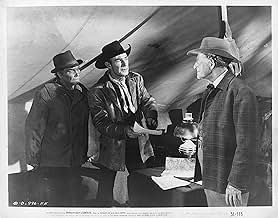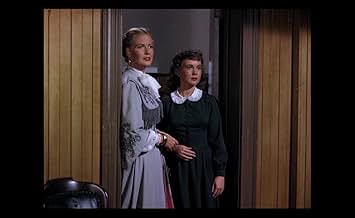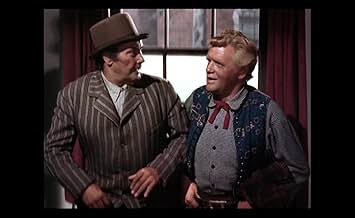AVALIAÇÃO DA IMDb
6,1/10
1,2 mil
SUA AVALIAÇÃO
Adicionar um enredo no seu idiomaAfter their service in the Civil War, four brothers go their separate ways, but later find themselves on opposite sides of a final showdown.After their service in the Civil War, four brothers go their separate ways, but later find themselves on opposite sides of a final showdown.After their service in the Civil War, four brothers go their separate ways, but later find themselves on opposite sides of a final showdown.
- Direção
- Roteiristas
- Artistas
Peter M. Thompson
- Tom Canfield
- (as Peter Thompson)
Olin Howland
- Dan Dugan
- (as Olin Howlin)
Jock Mahoney
- Crake
- (as Jock O'Mahoney)
- Direção
- Roteiristas
- Elenco e equipe completos
- Produção, bilheteria e muito mais no IMDbPro
Avaliações em destaque
The time period for this film is actually pretty common for a Randolph Scott western--and about the fourth or fifth one set just after the Civil War. Like most of the films, Randolph fought for the South and now that the war is over, he has a choice to either accept the outcome or be a whiny jerk about it. Well, he's a smart guy and soon gets a job working for the Santa Fe railroad, but his three brothers who served with him aren't so bright--they hate the North so much that they do what they can to wreck things--even though there is no reasonable reason for this. So, much of the film pits Scott against his own kin (and vice-versa) as he tries hard to get the railroad completed and they work to undo it as much as possible--working for a traveling saloon whose task, it seems, is to both make money off the workers AND get them distracted from their job.
In addition to his brothers, Scott deals with a wide variety of things that might impede the progress of the railroad--rival companies, local Indian tribes and the like. This makes Scott's job in the film as a sort of trouble-shooter. How true all these problems were in the construction of the rails is beyond me and I assume that the writers took a few liberties...just a few! Overall, the film is pretty good. While it isn't among Scott's best films (they were made later in the decade and the early 60s), this is a good film from this time period.
In addition to his brothers, Scott deals with a wide variety of things that might impede the progress of the railroad--rival companies, local Indian tribes and the like. This makes Scott's job in the film as a sort of trouble-shooter. How true all these problems were in the construction of the rails is beyond me and I assume that the writers took a few liberties...just a few! Overall, the film is pretty good. While it isn't among Scott's best films (they were made later in the decade and the early 60s), this is a good film from this time period.
Good but not great old time shoot-em-up western. Typical Randolph Scott pic. Brother agains brother tale. Old North/South post-war conflict. Certainly worth the 90 minutes. Good for a rainy day or lazy afternoon watch. Lots of cliches, but all good cliches. Nice cinematography. Trains. Nice sets and costumes. Black hats vs White hats. Decent acting by a lot of faces you recognize but do not know the names. Very good flat car fight on the train at the end. Of course Randolph (white hat) prevails. Last line is a classic. "As the railroad grows, so will America. You darn tootin. Please enjoy if you get the chance.
A former Confederate soldier takes a job building the Santa Fe railroad after the end of the Civil War and tries to persuade his three brothers to join him, fearing they will otherwise fall into a life of crime owing to their enduring hatred of the North
It's another solid Randolph Scott western, which covers the railroad expansion of SantaFe. The railroad and its set pieces convey the hard work that was done quite well. The conflict is on par too, which has Indians, gambling tents and rival companies disrupting Scott's efforts to build a railroad - but his brothers, who have gone on the outlaw track, make things awkward for Scott, and as a head of the family he takes upon himself to stop them. Which leads to gunfights, and particular exciting train fight between Scott and Jock Mahoney. It's a typically enjoyable western that also conveys the treatment of southerners from carpetbaggers and such like after the civil war.
It's another solid Randolph Scott western, which covers the railroad expansion of SantaFe. The railroad and its set pieces convey the hard work that was done quite well. The conflict is on par too, which has Indians, gambling tents and rival companies disrupting Scott's efforts to build a railroad - but his brothers, who have gone on the outlaw track, make things awkward for Scott, and as a head of the family he takes upon himself to stop them. Which leads to gunfights, and particular exciting train fight between Scott and Jock Mahoney. It's a typically enjoyable western that also conveys the treatment of southerners from carpetbaggers and such like after the civil war.
Train Buffs will Enjoy this Stiff Account of the "Iron Horse" and its Celebration as the Catalyst for "Manifest Destiny" that would Not be Denied.
It's Not Cinemascope, but a Technicolor Film.
The Post Civil-War Story and the Bitterness is Threaded Throughout the Plot but goes Virtually Nowhere.
The Acting is Stoic.
The Comedy Relief is Labored.
The Action is Average Stuff when it Occurs, and it's Not Often.
This is a Good Example of the Studio System Entering the Second Half of the 20th Century Riding the Rails of Past Glories.
Laziness Resulted in Bloated Productions that Became more Product than Art.
The Fat-Cats in Hollywood would Drain the System for another 20 Years before it Finally Gave Up the Ghost.
1950 was about the Beginning of the Decline.
There was a Sense of Atrophy as the Movie Machine made its way after a Two Decade Ride of Full Control.
Thankfully Randolph Scott would Ride the 1950's Proud as He Hooked Up with Budd Boetticher.
Excellent Movie Entertainment that were Self-Produced.
It's Not Cinemascope, but a Technicolor Film.
The Post Civil-War Story and the Bitterness is Threaded Throughout the Plot but goes Virtually Nowhere.
The Acting is Stoic.
The Comedy Relief is Labored.
The Action is Average Stuff when it Occurs, and it's Not Often.
This is a Good Example of the Studio System Entering the Second Half of the 20th Century Riding the Rails of Past Glories.
Laziness Resulted in Bloated Productions that Became more Product than Art.
The Fat-Cats in Hollywood would Drain the System for another 20 Years before it Finally Gave Up the Ghost.
1950 was about the Beginning of the Decline.
There was a Sense of Atrophy as the Movie Machine made its way after a Two Decade Ride of Full Control.
Thankfully Randolph Scott would Ride the 1950's Proud as He Hooked Up with Budd Boetticher.
Excellent Movie Entertainment that were Self-Produced.
Santa Fe is directed by Irving Pichel and adapted to screenplay by Kenneth Gamet from the James Marshall novel and a story by Louis Stevens. It stars Randolph Scott, Janis Carter, Peter M. Thompson, Jerome Courtland and John Archer. A Technicolor production, it's photographed by Charles Lawton Jr. Story is set following the American Civil war and finds Scott as Britt Canfield, one of four ex-Confederate brothers heading West for a new life. While Britt finds honest employment on the Santa Fe railroad, his brothers veer towards the other side of the law.
A routine Western boosted by some quality set pieces and a well crafted script. Watchable from the off, film follows a true course whilst launching off narratively from the bitterness still felt by those who were on opposite sides of the war. It pitches Scott front and centre as the stoic character fending off all sorts of challenges, challenges that come courtesy of Indians, rival companies and his own kin! The acting around Scott is pretty average, tho the comic relief from Billy House & Olin Howland is most appealing, while it would have been nice to have some more imposing scenery filling out the screen. All told it's a safe recommendation to Western fans, even if ultimately it's not a genre film to revisit often. 6/10
A routine Western boosted by some quality set pieces and a well crafted script. Watchable from the off, film follows a true course whilst launching off narratively from the bitterness still felt by those who were on opposite sides of the war. It pitches Scott front and centre as the stoic character fending off all sorts of challenges, challenges that come courtesy of Indians, rival companies and his own kin! The acting around Scott is pretty average, tho the comic relief from Billy House & Olin Howland is most appealing, while it would have been nice to have some more imposing scenery filling out the screen. All told it's a safe recommendation to Western fans, even if ultimately it's not a genre film to revisit often. 6/10
Você sabia?
- CuriosidadesAfter the Indian chief ran the train, Scott told the chief someday they will name a train after him. They did: the Santa Fe Super Chief.
- Erros de gravaçãoThe narration says Lincoln said "with malice toward none, with charity towards all" at Gettysburg. The quote is from his second inaugural address delivered at the capitol.
Principais escolhas
Faça login para avaliar e ver a lista de recomendações personalizadas
- How long is Santa Fe?Fornecido pela Alexa
Detalhes
- Tempo de duração1 hora 27 minutos
- Proporção
- 1.33 : 1
Contribua para esta página
Sugerir uma alteração ou adicionar conteúdo ausente


